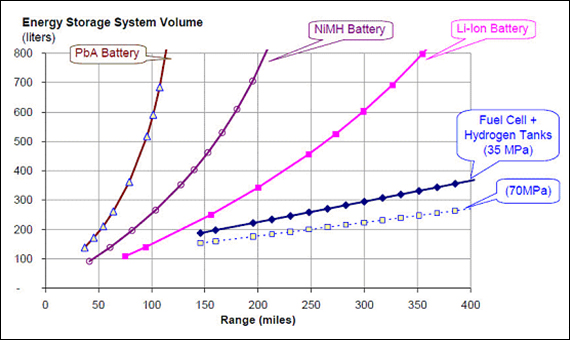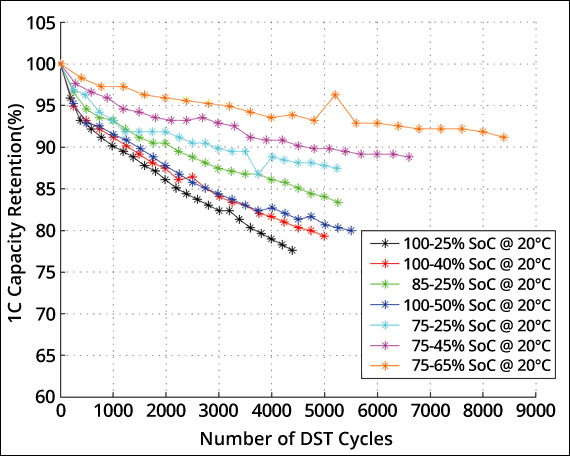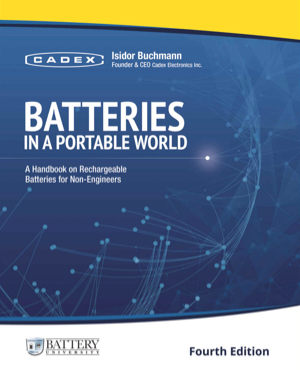Car makers are extending the driving range of the electric vehicle to resemble a gasoline-powered car. This requires larger batteries that grow exponentially with the distance driven. Figure 1 illustrates the estimated driving ranges with different battery systems and hydrogen as a function of size.
Doubling battery size does not extend the driving range linearly and the vehicle becomes inefficient with increasing weight. Li-ion performs better than lead acid in energy density, but no battery meets hydrogen with a fuel cell, or fossil fuel feeding the traditional internal combustion engine (not shown). Extending the driving range with a larger tank is almost negligible compared to oversizing a battery. There is a threshold as to battery size and weight in a vehicle; going beyond a critical point has a negative return and efficiency suffers because of increased vehicle weight.

Oversizing the battery does not expand the driving range linearly.
Note: 35MPa hydrogen tank refers to 5,000psi.
Source: International Journal of Hydrogen Energy, 34, 6005-6020 (2009)
Batteries have low calorific value compared to fossil fuel and it makes little sense to power a freight train, ocean-going ship or large airplane with batteries. A study reveals that replacing kerosene with batteries could keep an aircraft airborne for less than 10 minutes. Cost is another issue and batteries take long to charge. A fill-up that is quickly and conveniently as topping a tank with liquid or gaseous fuel is impossible with an electrochemical device. Charging also needs high power. An ultra-fast EV charge draws the equivalent electrical power of five households. Charging a fleet of EVs could dim a city.
Conversely, fossil fuel cannot match the qualities of a battery that is clean, quiet, and has an instant start-up with the flick of a switch. Although fossil fuel is cheap and readily available, frivolous burning of this resource must stop to save our planet. Finding alternatives that are environmentally friendly, economical and durable is a challenge; the battery fills this requirement only in part.
Advancements made in battery technology in the last 20 years are insufficient to replace fossil fuel. Pushing the boundaries of the battery reminds us of its many limitations, which include low energy density; long charging times, high cost and a short life before the packs quits, often without warning. Table 2 illustrates the energy densities of common fuels, including the battery.
| Fuel | Energy by mass (Wh/kg) |
|---|---|
| Hydrogen (350 bar) | 39,300 |
| Gasoline, diesel, natural gas (250 bar) | 12,000–13,000 |
| Body fat | 10,500 |
| Black coal (solid), Methanol | 6,000–7,000 |
| Wood (average) | 2,300 |
| Lithium-ion battery | 100–250 |
| Lead acid battery | 40 |
| Compressed air | 34 |
| Supercapacitor | 5 |
Table 2: Energy densities of fossil fuel and batteries.
Fossil fuel carries many times the energy per mass compared to batteries, but electrical power can be utilized more efficiently than burning fossil fuel.
Compiled from various sources. Values are approximate.
How to Prolong Battery Life
Driving range is a key consideration when buying an EV. Cost also plays a role but seldom is battery life mentioned. This may not be the concern for a tire-kicker, nor does the salesman want to alarm the buyer of possible service issues later on. What sells is the joy of electric propulsion that is clean, quiet and exhilarating. Taxpayer subsidies also help.
Batteries have a defined life span and this is apparent with the decreasing runtime in our mobile phones. EV advocates may argue that a smartphone battery cannot be compared to an EV battery; these products are totally different. That is true, but ironically both use lithium-ion systems. This article looks at the battery in an EV and mobile phone in terms of runtime and longevity.
The battery in the mobile phone is consumer grade, optimized for maximum runtime at low cost. the EV battery, on the other hand, is made to industry standards with longevity in mind. The dissimilarities do not stop there and a key difference is how the energy is dispensed.
A mobile phone gets charged at the end of a day and the stored energy can be fully utilized until the battery goes empty. In other words, the user has full access to the stored energy. When the battery is new, the phone provides good runtimes but this decreases with use. In this full cycle mode, Li-ion delivers about 500 cycles. The user adjusts to the decreasing runtime, and being a consumer product, the end of battery life often corresponds with a broken screen or the introduction of a new model. Built-in obsolescence serves well for device manufacturers and retailers.
The EV battery also ages and the capacity fades, but the EV manufacturer must guarantee the battery for eight years. This is done by oversizing the battery. When the battery is new, only about half of the available energy is utilized. This is done by charging the pack to only 80% instead of a full charge, and discharging to 30% when the available driving range is spent. As the battery fades, more of the battery storage is demanded. The driving range stays constant but unknown to the driver, the battery is gradually charged to a higher level and discharged deeper to compensate for the fade.
Once the battery capacity has dropped to 80%, the oversize protection is consumed and the battery maintenance system (BMS) applies a full charge and discharge. This exposes the EV battery to a similar stress level of a mobile phone and the driver begins noticing reduced driving range. Battery replacement may become necessary but the cost will be steep and higher than a combustion engine.
The EV begins to impersonate a mobile phone in terms of obsolescence when the battery fades. This may be the time when the buyer is flooded with faster and flashier models; something the smartphone user is all too familiar with, but price will be the shocker. It’s still too early to tell how long an EV battery will last. Some say the battery will outlive the car and find secondary application in energy storage systems.
Driving habits and temperature also affects aging, a characteristic that came to light when EV batteries operating in a warm climate faded prematurely. It was learned that keeping a battery at elevated temperature and high state-of-charge causes more stress than aggressive driving. In other words, keeping a fully charged Li-ion at 30°C (86°F) and above hastens the aging process more than driving at a moderate temperature. Many EV batteries include liquid cooling to reduce heat-related battery fade.
Harsh loading also reduces battery life. Because of its large size, the EV battery is only being stressed moderately, even during acceleration. In comparison, the mobile phone draws continuous high current from a small battery when transmitting and crunching data. This puts more stress on a mobile phone battery than driving an EV. A battery is also negatively impacted by the pulsed load of a mobile phone rather than the DC load of an EV. (See BU-501: Basic about Discharging.)
The EV does not disclose the battery capacity to the driver and only reveals state-of-charge (SoC) in the form of driving range. This is done in part for fear of customer complaints should the capacity drop below the mandated level at the end of the warranty period. Less knowledge is often better. The same restriction applies to a mobile phone battery, although access codes for service personnel are often available. A new battery has (should have) a capacity of 100%; 80% is the typical end of battery life.
Dynamic Stress Tests (DST) on Li-ion
All Li-ion batteries fade with time and use, whether in consumer products or enduring industrial use. Figure 3 explores the longevity of Li-ion batteries with different charge and discharge end points.

Limiting a full charge and discharge prolongs battery life but lowers utilization.
Source: ResearchGate – Modeling of Lithium-Ion Battery Degradation for Cell Life Assessment. ResearchGate is a social networking site for scientists and researchers founded in 2008 to share papers, ask and answer questions, and to find collaborators. Wikipedia https://www.researchgate.net/publication/303890624_Modeling_of_Lithium-Ion_Battery_Degradation_for_Cell_Life_Assessment
The Li-ion batteries in the above table perform well but the largest capacity loss occurs with the pack that is charged to 100% and discharged to 25% (black stars). Cycling between 85% and 25% (green) provides longer service life than charging to 100% and discharging to 50% (dark blue).
The lowest capacity loss occurs when charging Li-ion to 75% and discharging to 65%. This, however, takes oversizing to the extreme and the battery is underutilized. Such practice is applied in satellites to achieve high cycle life and less for terrestrial applications as it increases cost, size and weight beyond a reasonable point of return. The dynamic stress test does not include a battery that is charged to 100% and discharged to zero, as is the case with a mobile phone. A full cycle provides the best battery utilization but reduces longevity.
Batteries tested in a laboratory do not always replicate true life conditions, and the results tend to be better than experienced in field use. In a lab environment, batteries are cycled over a period of a few months, often at controlled temperature and with an ideal charge and discharge regime. Random usage in real life adds the exposure to heat, vibration and harsh charging practices.
Summary
Batteries do not have a fixed life span, nor do they die suddenly but fade gradually. Environmental conditions, and not cycling alone, govern longevity. The user has some control to prolong battery life by avoiding ultra-fast charges, operating at moderate temperature and avoiding full charges. Avoiding harsh loads and full discharges also helps. Heat is the enemy of most batteries and the worst condition is keeping a fully charged Li-ion battery at elevated temperatures. Even with the best of care, a battery only lives for a season and the pack will eventually face retirement when power fades.
About the Author
Isidor Buchmann is the founder and CEO of Cadex Electronics Inc. For three decades, Buchmann has studied the behavior of rechargeable batteries in practical, everyday applications, has written award-winning articles including the best-selling book “Batteries in a Portable World,” now in its fourth edition. Cadex specializes in the design and manufacturing of battery chargers, analyzers and monitoring devices. For more information on batteries, visit www.batteryuniversity.com; product information is on www.cadex.com.

Looking for comments from the previous website?
Comments from the previous website are not compatible with our new commenting system but we have preserved them so our users can still reference and make use the information in them.

Hi my name is Daniel and I have a question regarding lithium ion batteries for mobile devices The recommended way to charge this laptop is from 25% to 85% that the device is on? And for example if I want to charge up to 100% that the laptop is off it will not damage the battery?